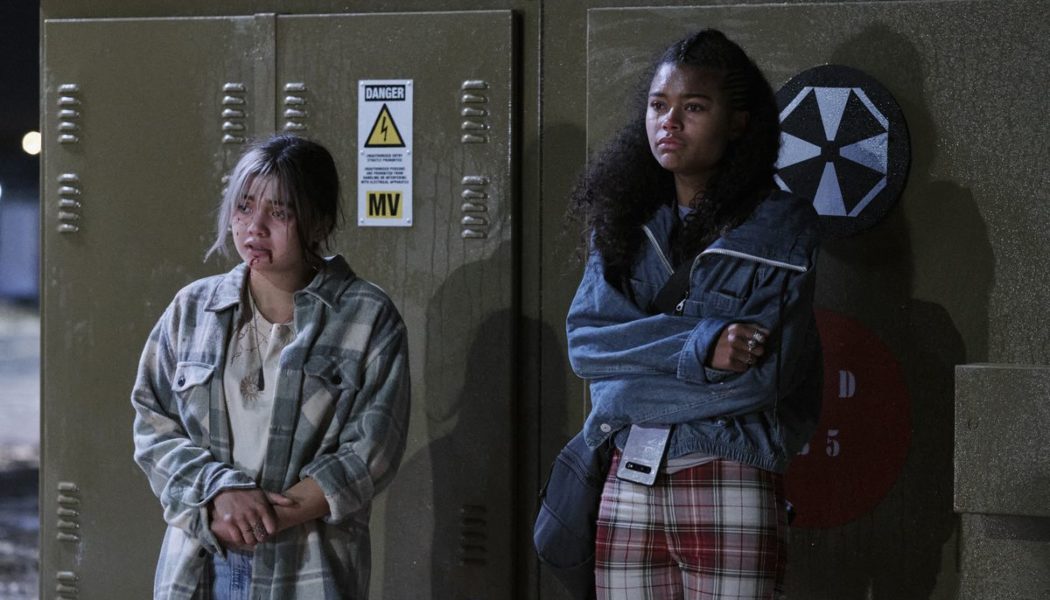Similar to how the fictional Umbrella Corporation struggled for years to understand the mutagenic T-virus, Capcom has spent decades trying to figure out how to produce live-action Resident Evil adaptations with broad appeal outside of the video games’ core fanbase. Netflix’s new Resident Evil series from Supernatural writer Andrew Dabb is wily and full of alarming surprises that speak to its potential to become a breakout hit. But much like the T-virus, the new show is as inconsistent as it is imaginative with an apocalyptic story that blends different pieces of Resident Evil’s past together as it creates a new future for some of the franchise’s most iconic characters.
Netflix’s Resident Evil tells the story of a slightly different yet very familiar version of Albert Wesker (Lance Reddick), one of Umbrella’s top executives who’s been overseeing the development of its latest pharmaceutical breakthrough — a drug dubbed “Joy.” With just a little bit more fine-tuning, Umbrella’s new multipurpose drug Joy could rid the world of depression and anxiety and make the corporation billions of dollars in the process. But, as tends to be the case with Umbrella’s miracle drugs derived from the T-virus, there are certain… complications that can develop from taking Joy, which is why this iteration of Wesker — a family man — wants to keep it off shelves.
Wesker’s tenuous morality makes him something of an unexpected hero as Resident Evil opens sometime in 2022, which is actually the series’ past. But as the show jumps back and forth in time between 2022 and its present day in 2036, Resident Evil gradually reveals that it’s really a story about Weskers’ fraternal twin daughters — two characters who were created for the new show.
:no_upscale()/cdn.vox-cdn.com/uploads/chorus_asset/file/23760036/ResidentEvil_Season01_165_R1.jpeg)
Though Resident Evil feels most on-brand when it’s following adult Jade Wesker (Ella Balinska) on her full on-apocalyptic journey to better understand the T-virus after the pathogen gets loose, the show’s at its most interesting in 2022 when it’s focusing on younger versions of Jade (Tamara Smart) and her sister Billie (Adeline Rudolph). It’s through the teen girls’ tense relationship with their father that the show first begins to drop clues about its connections to the larger Resident Evil franchise and how, different as things seem at first, looks are often deceiving when the Umbrella Corporation is involved.
Resident Evil finds a variety of different ways to play with this concept as it details how the Wesker family comes to settle in New Raccoon City, an eerie and somewhat exclusive township located in South Africa. Strange as the girls — two fraternal twins who’ve never been sick — find their new town, they understand that relocating there and providing their father with weekly blood samples are all part of Albert’s desire to keep them happy and safe. Out of the handful of classic Resident Evil characters from the games that Netflix’s show incorporates into its story, Albert is by far its most fascinating thanks largely to the steely, menacing energy Reddick brings to the role with his performance. As Resident Evil progresses, Reddick’s Wesker is shown in a variety of contrasting lights that do an effective job of illustrating why he became one of Umbrella’s power players and why his presence at the company puts powerful executives like Evelyn Marcus (Paola Núñez) on edge.
Given just how many Resident Evil adaptations there have been in recent years, the Netflix show’s way of playing fast and loose with the series’ lore works to keep things feeling somewhat fresh up to a point. But rather than placing Albert and the Wesker sisters at the center of a properly compelling mystery split across timelines, Resident Evil’s phones it in with a predictable plot that ultimately suffers from being such a late entry in the modern-day zombie craze.
:no_upscale()/cdn.vox-cdn.com/uploads/chorus_asset/file/23760112/ResidentEvil_Season01_086_R2.jpeg)
Despite its two time periods’ relatively close proximity to one another, Resident Evil often feels like two different shows as it shifts between its past — a The Walking Dead-style slow burn — and its grim present inspired by Paul W. S. Anderson’s Resident Evil films. A Resident Evil story about what it’s like to be a part of Umbrella (even just by relation) before shit hits the fan or how the company always manages to skirt governmental oversight and accountability could be legitimately interesting — especially given the shape of our real world. But none of Resident Evil’s potentially bright spots are ever capitalized on enough to outweigh the generally uninspired way the show works them into its first season.
As brilliant and suspicious of their father as the Wesker girls are, it isn’t until well into the show that either of them thinks to wonder aloud whether there might have been an old Raccoon City that their new city’s named for and what might’ve happened to the original. Resident Evil tries to root itself in time with real-world pop culture references and mentions of actual corporations like Eli Lilly.
In doing so, though, the show inadvertently highlights how uninterested it is in saying much of anything that could be interpreted as commentary about the COVID-19 pandemic. A Resident Evil series doesn’t need to have a deeper message about what it means to survive in a world overtaken by a dangerous virus. But Netflix’s timing and this being the streamer’s second COVID-era Resident Evil project makes it hard not to notice how the show would much rather have you thinking about things other than the pandemic.
:no_upscale()/cdn.vox-cdn.com/uploads/chorus_asset/file/23760420/ResidentEvil_Season1_001_R1.jpeg)
In an ideal world, Resident Evil would try to achieve that goal by presenting you with an assortment of pulse-pounding action sequences meant to evoke the horrific, survival-focused spirit of the video games. Here, though, the show mainly relies on hordes of sprinting, T-virus-infected “zeroes” to create an atmosphere of dread that ebbs and flows too quickly from scene to scene to ever become properly scary. Even when Resident Evil ups the stakes by introducing bigger, mutated monsters as part of its boss battle-like set pieces, the show’s heroes spring into action with a clunkiness fitting for poorly-controlled video game characters but less than ideal for characters on television.
As games, Resident Evil has managed to stay relevant largely because Capcom hasn’t been afraid to drastically reinvent the experience, like the terrifying shift to a first-person perspective in Resident Evil 7. The same hasn’t been true for the many film and TV adaptations, and Netflix’s Resident Evil is no exception. Experiencing Netflix’s latest series is almost like watching a streamer play one of the more forgettable entries in the franchise — and realizing part-way through that their controller has been disconnected the entire time.
That need not remain the case should Netflix decide to bring Resident Evil back for future seasons and go for even more of the big, ridiculous, disgusting ideas that have been keeping other parts of the franchise fresh lately.
Resident Evil hits Netflix on July 14th.









